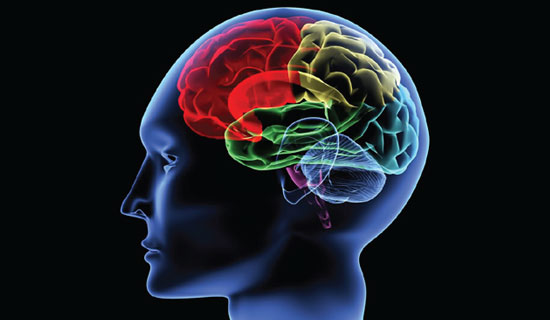
To mark the 30th anniversary of the RECORDER magazine, a nostalgic article. Back in the 70’s and 80’s theme albums were all the rage... Thick as a Brick, Dark Side of the Moon, Diamond Dogs, to name a few. Music, lyrics and art work combined into a united theme or story. Many of these themes didn’t stand up to close scrutiny, but recreational drugs helped music fans overlook shortcomings. One of my favourite albums was the Talking Heads’ Fear of Music. The whole album is infused with a sense of dystopian paranoia which I suppose was attractive to my youthful angst, but looking back now, I find it quaintly at odds with my currently optimistic outlook. I believe science and rationalism are taking us in a positive direction, rather than the creepy sort of future conjured up by the Talking Heads. However, science certainly has created some negatives as well.
Mind
The Edwin Smith papyrus (Wikimedia Foundation, Inc., 2015), Egyptian and dated to ~1600 BC, contains medical knowledge and procedures for a wide range of afflictions, especially focusing on injuries suffered during combat, and is the oldest known clinical/ rational style medical treatise. It documents the connection between the brain and a broad range of body functions, and clearly identifies the brain as the ‘control centre’ for the body. It is intuitively obvious that our thoughts are created and reside in our heads (it’s interesting to ponder why this is) and the effects of head injuries would have confirmed this since time immemorial. In around 450 BC Hippocrates wrote, “Men ought to know that from the brain and from the brain only arise our pleasures, joys, laughter and jests, as well as our sorrows, pains, grieves and tears.”
Brain studies advanced slowly, and most theories from the pre-modern era seem ludicrous from today’s perspective. In the 1800’s behavioural sciences such as psychology began to establish themselves and document mental maladies in clinical terms. Recently scientific advances have been significant in many different fields, especially in terms of connecting observed behaviours and actions to specific areas of the brain and their neurological mechanisms. Despite these advances, understanding the brain is one of the most challenging areas of current scientific research, and the unknowns probably still significantly outnumber the knowns.
In recent years an evolutionary model for the brain has become broadly accepted, and I certainly adhere to this explanation. It holds that each part of the human brain represents an incremental “improvement” as our species evolved over time. If the brain is broken down into parts, some are essentially the same as those in creatures whose common ancestor with humans would have lived very long ago; an example of this is the cortex, which is found in humans as well as in fish and all other vertebrates. If one follows along the path of human evolution, this pattern of shared brain parts is seen over and over, all the way to our most recent and closest relatives, the great apes, whose brains closely resemble our own. I like to view this as similar to the evolution of the car engine, with newer and more advanced parts being added along the way, such as starter motors, fuel injection, computer control systems and so on. With this fundamental model in mind, researchers probe the functions of all the brain’s parts, and their integration into the incredibly complex thing we know as our mind. What it means for us humans is a great improvement in helping people deal with mental afflictions, from serious ones like bipolarity all the way to subtle ones like mild dyslexia. Personally I prefer a world where psychological problems are understood, and people aren’t locked up in madhouses.
Paper

The oldest piece of paper, discovered in China’s Gansu province, has been dated to between 179-41 BC. Similar to other technologies, paper making spread slowly westward over many centuries – Pakistan in the 8th century AD, Baghdad 8th, Sicily 10th, Morocco ~1100 AD, and Germany in the 1400’s. Science has driven the improvement of paper and its manufacture. A big step forward was the development of water-powered mills, then steam; prior to this fabric pulp was pounded manually with pestles. Applied science in the mid-1800’s allowed wood pulp to replace fabric fibre pulp, and the pulp bleaching process quickly followed, making paper an affordable mass consumption product. Modern era advances followed, especially in the chemical and material sciences, giving us a huge variety of paper types, mainly achieved with sophisticated bonding and coating materials which determine weight, colour, absorbency, smoothness, strength, water repellency, UV resistance, etc. Each sheet of paper is a technical marvel, and it is science that brought us from dried reeds and animal skins to this. Paper products constitute ~35% by weight of municipal solid waste, and “pulp and paper is the third largest industrial polluter to air, water, and land in both Canada and the United States, and releases well over 100 million kg of toxic pollution each year” (Wikimedia Foundation, Inc., 2015), not to mention deforestation, habitat loss and associated impacts.
Cities

Science has helped cities efficiently deliver clean water, sewage removal, light, heat and so on, but on the other hand, made it possible to pack people together in numbers and densities that would appear hellish to our recent rural ancestors, and totally alien to our distant hunter-gatherer predecessors. In Jared Diamond’s The World Until Yesterday (Diamond, 2012) he describes how measures of human happiness are higher for primitive hunter-gatherer people who spend proportionally more of their time doing fun stuff (whatever that is for hunter-gatherers) than for large city dwellers who spend the majority of their time at and travelling from / to work, with less left for leisure activities. I’m sure the millions of slum dwellers around the world would concur. This raises a very fundamental question, which is whether science with all its advances has really benefitted the human race? Would we be happier living short, disease and violence plagued but emotionally fulfilling lives in small tribes, rather than emotionally emptier ones crammed into cities with modern medicine, long life spans, and all the other benefits of modern society? One theory is that traditional hunter-gatherer societies achieve affluence through desiring less and gathering enough, while modern societies want more and produce more. Has science simply allowed us to produce all sorts of things we don’t really need? Food for thought…
Memories Can't Wait

The study of what exactly memories are and how they are encoded, stored and retrieved is a very fascinating and active area of scientific research. In times gone by the belief was that the human brain was a somewhat magical organ that could do almost anything, including create and work with memories – it was all part and parcel of being human. Now science is probing deeper, much like it has done with understanding matter – first at a molecular level, then atomic, and now sub-atomic. We now understand that memory is not a single function but is really a combination of distributed processes involving many parts of the brain.
For me to recall the album Fear of Music involves a retriggering of the neural patterns that were originally generated when the memories were first encoded. That original experience itself was a combination of several different sensory systems, each involving a different part of the brain: the occipital lobe was triggered by the black album cover as I looked at it, the parietal lobe as I touched its metal grate-like bumps, the temporal lobe as I listened to its rhythms (Tina Weymouth on bass!), the cerebrum as I contemplated its lyrics, and perhaps the frontal lobe triggered endorphin rewards for being such a cool guy to listen to such a cool album. So when I now think about Fear of Music, something (the hippocampus?) recreates that complex net of neural patterns originally formed back in 1979, and the illusion of a seamless memory of it. Memory is a complex and interesting topic I’ll try to cover in a future article.
Air
Before science came along, we had a very limited understanding of what air was, but it’s not like humans were clueless. They understood that air contained some vital life-giving ingredient. They understood that air was something not nothing, and obviously developed a practical understanding of wind and how to harness it via windmills and sails. The science of aerodynamics followed a developmental thread that involved some scientific greats, including Aristotle, Archimedes, Newton, Bernoulli, and Cayley; the latter defined the 4 fundamental elements of flight – lift, drag, thrust and weight. The scientists who pushed along our understanding of air’s composition were not so well known, and included the unfortunately named Richard Assmann. Thanks to Assmann and others, we now know that air is a combination of gases, primarily nitrogen (78.09%) and oxygen (20.95%), and varies considerably depending on altitude and location, especially in terms of density and water content. Ironically, the science that gave us a complete understanding of air also led to the many pollutants that make it a health risk today. These include sulfur and nitrogen oxides, carbon monoxide, toxic metal compounds, CFC’s, particulates, and many others. Air pollution, much of it anthropogenic, kills an estimated 7 million people a year.
Heaven

In a 2011 interview, Stephen Hawking famously stated, “[heaven is] a fairy story for people afraid of the dark.” But a surprising number of scientists, who one would imagine as being very rational and non-spiritual like Hawking, express a firm belief in heaven and other religious appurtenances. One day science might be able to prove the existence of heaven, supreme beings and all that, but perhaps a more realistic question to ask is, can science explain the broad and pervasive existence of religious beliefs among humans worldwide? As I often do, I turn to Steven Pinker for his thoughts. Clearly on the “no God” side, over the years he has offered many rational explanations why religion exists, neatly summed up in his address to the 2004 meeting of the Freedom from Religion Foundation, on receipt of “The Emperor’s New Clothes Award”:
“There is an alternative explanation, namely that religious psychology is a by-product of many parts of the mind that evolved for other purposes. Among those purposes one has to distinguish the benefits to the producer and the benefits to the consumer. Religion has obvious practical effects for producers. When it comes to the consumers, there are possible emotional adaptations in our desire for health, love and success, possible cognitive adaptations in our intuitive psychology, and many aspects of our experience that seem to provide evidence for souls. Put these together and you get an appeal to a mysterious world of souls to bring about our fondest wishes” (Pinker, 2004).
Animals
Science has been a double edged sword for animals. Science has clearly demonstrated that we humans are animals, and while we are special in many ways, so too is each type of animal, uniquely adapted to its ecological niche. Individuals in modern societies therefore tend to have far more empathy towards animals, and are less likely to view them as dumb creatures incapable of feeling pain or emotion; the ethics surrounding our treatment of animals have changed greatly in lockstep with our far greater understanding of them. For example, Quebec recently changed the legal status of animals from ‘property’ to ‘sentient beings’. However science has also given us better tools to catch, breed, fatten, harvest and otherwise exploit animals to not only feed the alarmingly increasing numbers of humans, but also to “improve our quality of life” in other ways – as working slaves, as test subjects, as mindless companions, etc. If anyone should relate to the dystopian angst of Fear of Music it should be animals! I can picture them chanting altered lyrics:
Humans think they understand
Most of them are a big mistake
Humans want to change my life
I will ignore, I don’t know such placeThey think they know what’s best
They’re making food of us
They like to laugh at animals
They’re making a bad example
Electric Guitar
With the advent of the big band era in the early 20th century, stringed instruments struggled to be heard over the much louder brass and percussion sections of the bands. Inventors tried many different approaches to electrically amplify the sounds emanating from guitars, violins, and other string instruments. The Rickenbacker Electro Stringed Instrument Company came out with what is generally recognized as the first electric guitar in 1931. It had a cast aluminum body, meaning there was no sound generated by resonance within a hollow wood body – the sound was entirely created by converting the vibration of the strings into a current, and then the current into sound via speakers.

The pickup – the electrical device that converted the strings’ vibrations into a current – was primitive, but today’s modern guitars employ the same elements albeit greatly improved. There is a pickup located under each string (Fig. 1). The pickup is a magnet with thin copper wire tightly wound around it in thousands of turns. When the string vibrates, the ambient magnetic field created by the magnet is distorted, and this induces a current in the wire; technically speaking the pickup is a transducer converting mechanical energy into electrical energy. The current varies depending on the amplitude and frequency of the string’s vibrations. In addition to amplification, it can also be modified by reverb, distortion and other analog tricks. Double coil pickups (humbuckers) contain two magnets of opposite polarity, meaning that unwanted 60 Hz power supply noise cancels out. Modern guitars often house several pickups per string to create a broader sonic palette. Piezoelectric and optical pickups are used to amplify traditional acoustic instruments. They are mounted on the wood bodies of the instrument, and convert the physical vibrations of the wood into current. James Maxwell would love all this.
Drugs
Drugs aren’t new – medicines such as an anti-bacterial birch fungus were found in the belongings of Ötzi, the ~5,400 year old male corpse found preserved in the Tyrolean Alps. Humans since time immemorial have consumed naturally derived substances in order to address health issues. And of course our ancestors used drugs for recreational purposes as well, often with connections between religious rituals and drug use, also well evidenced in the archaeological record. At the risk of offending religious sensibilities, even today churchgoers drink wine, Rastas smoke weed, Fijians drink kava, and so on – drugs have a long history as a perceived way to communicate with or understand the divine. Beyond their mystical properties, drugs tap into our bodies’ natural reward systems, and can become addictive, hardly an advancement.
On the other hand, drugs have legitimately improved the quality of human life, through the reduction of pain, reduction and in some cases elimination of infection and disease, and have greatly lengthened life spans. Say what you will about drugs, there is no denying that advancements in drug design and manufacture are among humans’ greatest scientific achievements. We now have drugs that are able to subtly alter neurochemical processes, drugs that can bring cancer sufferers across death’s doorstep and back, and drugs that help our bodies fight off the nastiest things nature throws at us. We even have drugs that make otherwise unbearable music (and I’m not putting the Talking Heads music in this category) seem enjoyable!











Share This Column